 |
Number of versions: 12
Edition: March 1, 2000
Updated: August 23, 2012
|

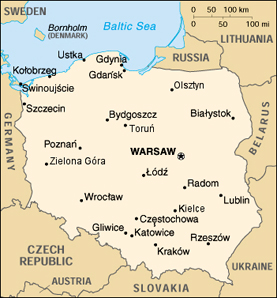
Like in other former East bloc countries the games of Parker Brothers/Hasbro
appeared for the first time in 1993 in Poland. Also for Poland it was choosen
for the streets of the capital city, WARSAW. From Start on they are successively:
Ulica Konopacka - Kasa społeczna
(Community
Chest) - Ulica Stalowa -
Podatek dochodowy - Dworzec
Zachodni Polskie Koleje - Ulica Radzyminska - Szansa
- Ulica
Jagiellonska - Ulica Targowa - W
Wiezieniu (In
Jail) - Ulica Plowiecka -
Elektrownia - Ulica Marsa - Ulica Grochowska - Kasa społeczna
(Community
Chest) - Ulica Górczewska
- Ulica Wolska - Bezplatny Parking (Free parking) -
Ulica Mickiewicza - Szansa
- Ulica Slowackiego -
Plac Wilsona - Dworzec
Wschodni Polskie Koleje - Ulica Swietokrzyska -
Krakowskie Przedmiescie - Wodociagi (Water)
- Nowy Swiat -
Do Idz Wiezienia (Go
to Jail)
-
Plac Trzech Krzyzy - Ulica Marszalkowska - Kasa społeczna
(Community
Chest) - Aleje Jerozolimskie -
Dworzec
Centralny Polskie Koleje Szansa
- Ulica Belwederska
- Domiar
Podatkowy (Luxury
Tax) and Aleje
Ujazdowskie.
 Edition: Super***Monopoly Edition: Super***Monopoly
Gra dla młodzieźy i dorosłych (A
game for teenagers and adults)
Publisher: Inland manufacturer
ELLERT/ET - ±1990
Dimensions of the box: 26 x 43 cm
The game:
This set is owned by Adrian Lancucki - Legnica
- PL.
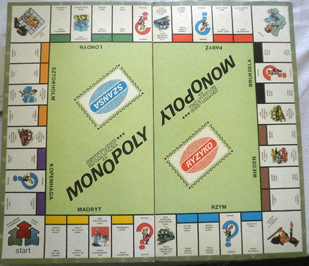 This game is one of those from the communist period,
taking place far over the
countries' border:The streets are those of 8 European Countries,
from Start (1) onwards: This game is one of those from the communist period,
taking place far over the
countries' border:The streets are those of 8 European Countries,
from Start (1) onwards:
Kopenhaga: Shaelland (2) - Szansa (3)
- Amager (4)
Sztokholm: Norrmalm (6) - Podatek
Dochodowy (7) -
Gärdet (8) - Enskede (9) - Tylko dla odwiedzających (10)
Londyn: Greenwich (11) - Elektrownia
(12) -
Chelsea (13) - City (14) - Ryzyko (15)
Paryż: Champs Elysées (17) - Szansa
(18) - Saint Denis (19) - Montmartre (20) - Relaks (21)
Bruksela: Saint Gilles (22) - Ryzyko (23) - Grande Place (24)
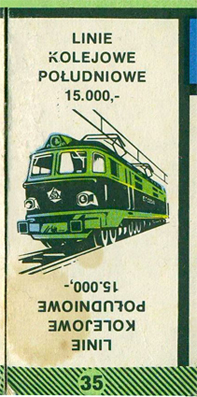 Wiedeń: Graben (26) - Podatek od
Luksusu (27) - Hoher Markt (28) - Opernring (29) - Za winiłeś
idziesz do więzienia (30) - Wiedeń: Graben (26) - Podatek od
Luksusu (27) - Hoher Markt (28) - Opernring (29) - Za winiłeś
idziesz do więzienia (30) -
Rzym: Cinecitta (31) - Szansa
(32)
- Piazza Venetia (33) - Via del Corso (34) - Ryzyko (36)
Madryt. Salamanca
(37) - Sieć wodociągów (38) (water supply network)
- Calle de Alcalá (39) and Puerta del sol (40).
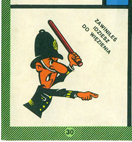 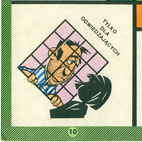 Only the stations are Polish: Linie Kolejowe Północne
(5)(Northern Railways) - Linie Kolejowe Za'Chodnie (16)(Western
Railways) - Linie Kolejowe Wschodnie
(25) (Eastern Railway Lines) and Linie Kolejowe Południowe
(35)(Southern Railways).
Only the stations are Polish: Linie Kolejowe Północne
(5)(Northern Railways) - Linie Kolejowe Za'Chodnie (16)(Western
Railways) - Linie Kolejowe Wschodnie
(25) (Eastern Railway Lines) and Linie Kolejowe Południowe
(35)(Southern Railways).
The Water Works (38) are represented by a washbasin!
The box looks like the Waddingtons' (red
box with white band). The streets of the mentioned cities are, from Start on,
numbered along the edge of the soft gameboard. Its midfield is light
green. De plastic houses are dark
grey and the
hotels are light grey.
The tokens
are simple plastic pawns.
There are 6 banknotes from
SUPER***MONOPOLY with a value statement in a bar along a short side: 100
- 500 - 1 000
- 5 000 -
10 000
and 50 000.
Both dice are blue with gold pips.
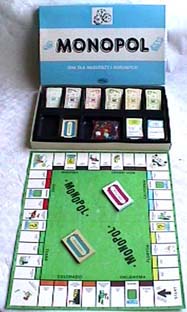 Edition:
Monopol Edition:
Monopol
Publisher: Inland manufacturer Pilich - ±1991
Dimensions of the box: 26.2 x 43.2 cm
The game:
Characteristic of the MONOPOLY issues of Pilich are 3 illustrations on the lid
who also appear on later issues, viz.:
- Three dice (on later issues only 2?!)
- A stack of coins
- A stack of banknotes
The cover of this poor box has three bars in the colors blue/white/blue.
In this version it concerns cities of the American States:
Oklahoma - Colorado - Texas - Ohio - Virginia - New Jersey - California and
Florida. Of course wellknown cities are chosen for each state. So the cities of
California are San Diego, Los Angeles and San Francisco.
The classification of the gameboard however, deviate from the
standard game. The stations are (exsisting?) monorail
stations in Poland? Also on the edge of this board of soft carton the
fields are numbered from 1 to 40. In the box is a black, plastic tray for the
banknotes and the 28 property deed cards. The (2x16) cards are
called Szansa (dark lilac)
and Ryzyko (blue),
what may be clear enough! The stacks of these cards are in the opposite corners
then usual with the regular Monopoly game. In this game a policecar nicely
brings you to prisson! The money consists of 6 simple notes
with 2 dollar signs and a lion in the centre. The denominations are resp.: 100 (blue)
- 500 (green) - 1000 (beige)
- 5000 (purple) - 10.000 (brown)
en 50.000 (lilac).On Start one
receives $ 15,000.-. Made of simple plastic are: red
houses, brown hotels
and but 5 pawns as tokens. The dice are white
and light blue and have hollow
pips.
The inner box contains an insert of black
plastic with 6 trays for the banknotes and 5 trays for the other attributes.
The price of this set amounted to US$ 12.- in March 1992.
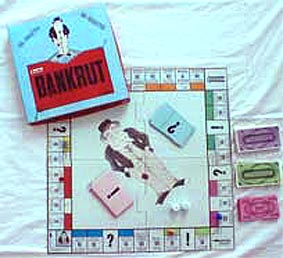 Edition:
Bankrut, Polish patent nr. W-3725 Edition:
Bankrut, Polish patent nr. W-3725
Publisher: Inland manufacturerA.B.Soroko - Skwierzyna - ±1992
Dimensions of the box: 23.8 x 23.8 cm
of the board: 42.7 x 42.7 cm
The game:
The upper side of the cover of the box is blue
with the name of the game BANKRUT in a large red
field. Above that a very strange member of Uncle Pennybag's family is obviously
present! The instructions are sticked on the inside of the cover. The gameboard
of stiff carton has to be built up of 2 puzzle parts! On the midfield "mister
Bankrut" is present again in all clearness! At his left and right side are
the fields for the stack with 15 blue
cards with ? as well as the 15 pink
cards with a !.
Although there is talk of a Polish patent the classification of the gameboard is
"according to Monopoly". It concerns streets of the cities Lowics,
Gorzow, Lodz, Radom, Lublin, Szczecin, Wroclaw and
finally the capital Warszawa with the streets Niska and Panska.
The stations are those of the adjacent cities, viz. Lowicz Glowny, Lodz
Kaliska, Szczecin Glowny and Warszawa Ochota..
"Go to jail" is here called ARESZT. Even Electric Company and Water
works are present and at the usual places! On Start one receives 100 ducats. The
banknotes are printed on white paper, at one side a
mathematical pattern, at the other side its value in writing. Each value has an
other colour. Each note is 3 times provided with 2 signatures! The 5 tokens
are simple hollow pawns. The green hotels
with overhanging roofs are substantial bigger than the light
braun houses.
The price of this set amounted to ZL60,000 (US$ 2.50) in May 1993.
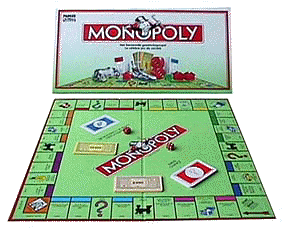 Edition:
Standard, ref. 06951POL120 Edition:
Standard, ref. 06951POL120
Publisher: Parker Bros./Tonka Corp. - 1993
Dimensions of the box: 26 x 51 cm
The game:
This game again is one of the the "series 1993 of Irish make", so with
on the cover the banknotes stack, 2 red dice,
the car and the shoe, Title Deed cards, one green
house and 3 red hotels, all in
perspective on the fourth side of the gameboard. A color picture at the back
side of the box shows a happy family playing Monopoly (with a German
gameboard!).
The board shows the red Szansa
space with ? and the blue
space Kasa Spolecznia, with opened treasure chest. On Start one
receives 2000 ZL. The banknotes delivered with this set are of
"class C", i.e. with the notation MONOPOLI - MONOPOLY - MONOPOL as
well as the statement "1992-Tonka Corporation". There are 10 metal tokens
("made in China") viz. the well-known dog, hat, shoe, thimble, car,
wheelbarrow, boat, canon, iron and rider-on-horse. The red
hotels are exactly those showed on the lid, viz. with roof edge and
without chimney, whereas the green houses
do have a chimney.
The price of this set amounted to ZL 49.40 (US$ 26.-) in December 1995.
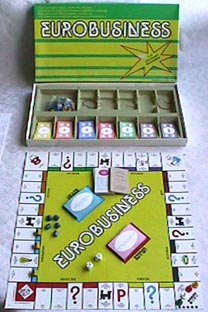 Edition:
Eurobusiness, NR TW001 Edition:
Eurobusiness, NR TW001
Publisher: Labo - ±1994
Dimensions of the box: 25.5 x 49.4 cm
The game:
Again the game is of poor quality, but the idea differs again! This time it are
cities of the 8 European countries: Greece - Italy - Spain -
England - Benelux (!) - Sweden - Germany and Austria.
The classification of the board of this publisher strikingly
shows much resemblance with the meanwhile by Hasbro-Poland issued game! Very
recognizable are:
 | the black Parker Brothers engines on the stations |
 | the red ? on
the Chance spaces |
 | the jailbird behind 3 bars |
 | the red car-with-white-tyres
on the Free Parking corner |
 | "Officer Edgar Mallory", the policeman who
directs you to jail |
 | the gold ring with diamond on the Super Tax space. |
However the colors of the streets all differ. The "red
street" for example is green
here and allotted to the Benelux state (!) with the cities Rotterdam, Brussels
and Amsterdam. Also here the fields are numbered from 1 to 40. On the
yellow
centrefield are a red
and blue area destined for both
stacks of Szansa cards.
The money consists of strongly Monopoly money resembling
Eurobusiness dollar notes. The 7 deniominations are resp.: 5
- 10 -
20 - 50
- 100 - 500
1.000.
On Start
one receives in this game but $ 400.-. The innerbox contains a
tray of grey plastic. The beige
hotels and blue houses
as well as the 5 tokens are again of poor plastic.
Both dice
are white and have hollow pips.
The price of this set amounted to US$ 13.- in May 1996.
Note from August 2012: Adrian Lancucki
remarks that this edition still today is the most popular one
"Monopoly" in Poland, mainly because of it's price, He saw prices
of 35 pln (€ 8.50) and 20 pln). People are buying like crazy!
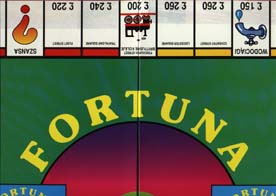 Edition:
Fortuna Kolem Sie Toczy Edition:
Fortuna Kolem Sie Toczy
Publisher: unknown inland make - ±1994
Dimenions of the box: 26 x 51 cm
The game:
The box is striking colorful, showing a brother (?) of Uncle Pennybags! Nothing
indicates any relation to Waddingtons, but the game contains the well-known
streets of London whereas all amounts are in English pounds!
Both parts of the solid game board are sticked together by a
piece of brown packing tape. The midfield of the playside is green
with a red circle
in the centre. Remarkable is the again different Jack the Jailbird, this time
with a striped cap, putting his head outside the bars! Exactly the same
illustration is placed in the third corner. The explaining text on the stations
with their funny locomotive reads: British Railways.
The colorful cards are called Fortuna Szansa
and Fortuna Wspólna Skrzynka. The banknotes
look a bit like Monopoly money and are of the denominations Ł 1 - 5 - 10 - 20 -
50 - 100 and 500. There are but 4 simple pawns as tokens. The
plastic houses with overhanging roofs and excentric placed
chimneys are olive-colored and the
hotels are blue.
Both dice are white with hollow black pips
This set was bought in June 1995.
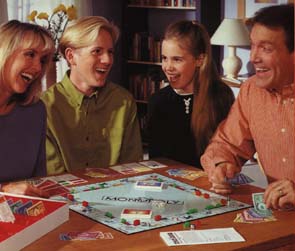 Edition:
Standard, ref. 14535 Edition:
Standard, ref. 14535
Publisher: Parker Bros./Hasbro - 1996
Dimensions of the box: 26.8 x 40.3 x 5.3 cm
of the quad folded board: 25.2 x 25.2 cm
The game:
Remarkable of this game are the new dimensions of the box. Hasbro advises
that this is because of "standardisation" of the shapes of their sets.
So from now on the long box we till so far called Standard disappears.
In this new box is one red, plastic insert
containing 7 slots for the banknotes, 10 slots for the property cards and 4
trays for the other equipment. The board is quad folded, like in the so
called "small box". Its back is red,
the play side is blue green. The word
MONOPOLY stays in black characters and in a frame diagonal wise over the board.
This set is made in Ireland and SO it has a picture of the laughing family on
the bottom again.
On the game board are those nice Szansa en Kasa
Spolecznia cards. They are white with the text in a frame printed in red.
The back side of the Kasa Spolecznia cards is blue
with a treasure chest in a yellow
field;
those of the Szanza cards is red with the ?
in a yellow field as well.
The property cards do not have rounded corners as a result of what they
look like slightly larger (dim.: 56 x 87 mm). The back side of these white cards
is printed red.
The banknotes are of the new model, viz. with a black ribbon with
"MONOPOLY with Uncle Pennybags" in the upper part of the circle and,
hardly visible, the remark "1996 Tonka Corporation" in the lower right
corner.
The 10 tokens are of pewter (without the mention "made in
China"). The green plastic houses
do have a chimney, the red hotels don't!
Both the dice are white.
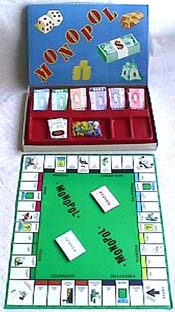 Edition: Monopol
- blue lid Edition: Monopol
- blue lid
Publisher: J.i.K.Pilich - Minsk Maz. - ±1996
Dimensions of the box: 27.7 x 43.2 cm
The game:
Although this is a few years more modern issue its quality has not been improved:
both the box and the game board are made of the same soft cardboard as in 1991.
The presentation of some parts has become a bit nicer like:
 | The lid is more coloful. |
 | The banknotes having a more modern design. The
denominations however are not changed and so are their colors (although there are
shade
differences). |
 | The Szansa and Ryzyko cards have a bloc
pattern instead of closed field. |
 | The color bar of the property deeds: The text is white
now situated in a colored field. |
Characteristic for this edition are:
- The 30 houses are of yellow
plastic, whereas the 10 hotels are blue.
- The tokens are now hollow "pointed caps".
- The insert of the innerbox is of
red plastic.
The price of this set amounted to US$ 22.- in September 1996.
 Edition:
Monopol - pink
lid Edition:
Monopol - pink
lid
Publisher: J.i.K.Pilich - Minsk Maz. - ±1997
Dimensions of the box: 27.7 x 43.2 cm
The game:
Like in the "blue edition"
of this game the full address of the manufacturer is given on one rim of the
lid! (The city of Minsk Mazowiecki is situated 40 km from the capital city of
Warsaw.)
Characteristic for this edition are:
- The board of soft cardboard consists of 2 parts,
unequally sticked together by a dirty yellow
tape! It's play side is turned outwards.
- The 30 houses are of lightbrown
plastic, while the 10 hotels are black.
- The tokens are the same hollow "pointed caps"
as with the "blue edition".
- The insert of the innerbox is of
black plastic.
The price of this set amounted to ZL 15.30 (€3,85).
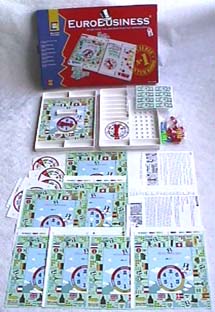 Edition: EuroBusiness
- 8 languages edition, Nr. Art.23708 Edition: EuroBusiness
- 8 languages edition, Nr. Art.23708
Publisher: Inter Kobo s.c. - Lodz - 1999
Dimensions of the box: 25.8 x 40.7 x 3.3 cm
of the small box: 18.5 x 25.0 x 3.0 cm
The game:
It is not clear if there is any relation between the firm Labo
(1994) and Inter Kobo, but the only resemblance between the
equally named games of both publishers is the fact that the properties concern a
number of European countries. There is also a relation suggested with Parker
Brothers in this game by a kind of Uncle Pennybags on the banknotes and his hat
on the Chance spaces of the little game board.
The large box in which the set is packed makes suppose that there is a large
game board, but that is not so. The small box of white plastic must be pushed
out of the beautiful outer box via a short side. It turns out to be a kind of
"travel edition" of a game with the 10 European countries
Greece - Belgium - Spain - Denmark - England - France - Germany - Netherlands -
Italy and Switserland. So Poland itself does not
appear on the board!
This originally Polish game is "Made in China" and contains in
addition 7 stickers of the board in the languages Russian, Czechian, Lithuanian,
Latvian, Hungarian, German and English. The play field (the sticker of the
selected language) must be put in the bottom section of the
box. Each side of the board has but 7 spaces and each country has 1 field with
its flag and name and a second field with a landmark of that country. In the
middle of the board is a partition Lucky Pool and a red
arrow-over-a-space with figures from 1 to 6 and 3 outer sections:
 | red = not accepted (only on
the Hungarian sticker this text is exchanged for the one of the beige
field!), viz. you may not build |
 | beige = accepted
= viz. you may build 1 house and
pay the amount to the bank |
 | blue = free, viz. you may
build 1 house for free! |
This arrow acts as a die. The lid section
also has an arrow-over-a-space. This acts as a Chance space. In
addition are 8 little trays (of which 5 for the small banknotes) and "openings"
(from A to I and U) for the 40 plastic pegs in the colors red,
yellow, green
and blue and the 10 red
houses. There are 4 tokens shaped as colored
plastic airplanes!
Houses can be built on the properties with a flag. However, if you may build
depends on which part of the circle the arrow points out when you turn the arrow
for the second time (see above). As proof you put a peg of the same color as
your airplane in the opening next to the flag on the space of the board. For the
second and third house you move the house from the first opening to the next
ones. So your properties are determined and it is not necessary to collect
streets of a color group. Besides you have to consider next points:
 | On the "sightseeing space" next to your own property one has to
pay or get paid (!) but this is business for the banker. |
 | Even if you are sent back to Start you will receive 100
$! |
 | In case you land on one of the 4 spaces with the hat, a Chance field, you
must rotate the arrow in the lid section. There you run the risk of paying
or receiving. All these transactions run via the "Lucky Pool" tray
on the centrefield of the game board. |
 | You may own 5 properties at the maximum. |
 | When you land on a space with flag without having sufficient capital you
still may turn the arrow counting on the possibility of landing on the
"free" blue section! |
The game is over as soon as one player run out of money.
The price of this set amounted to ZL 56.- (US$ 14.-) in October 1999.
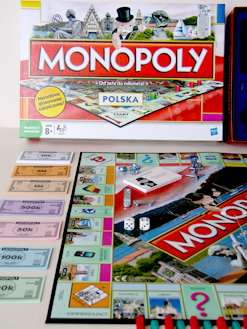 Edition: Country version: Polska - long box , Ref. 061101610120 Edition: Country version: Polska - long box , Ref. 061101610120
Od
zera do milionera! (From zero to millionaire!)
Manufactured by: Hasbro S.A.- Delémont CH
or "Made in Ireland"?
Represented by: Parker/Hasbro Europe -
Uxbridge -UK - 2011
Dimensions of the box: 26.8 x 40.3 x 6.5 cm
of the quad folded board: 25.2 x 25.2 cm
The game:
Analizing the reference number of this edition it tells us:
0611 = this edition was designed in June 2011. (However, published not until
in September 2011.)
01610 = it is a version close to the world edition
(ref.nrs.1611/12 and 13) and close to the square boxed special country
edions with flag (ref.nr.1603, see Finland and Sweden)
120 = the ref. number for the country of Poland in Hasbro's files.
It is striking to see in how a terrible complicated way the designers of this version are trying to tell us (or even hide for us) where the game is
made. What to think of this construction?
Left from the barcode, on top the CE-sign is said: "Wyprodukowano
przez Delémont - CH" = Made by Hasbro - Delémont - CH
And at the right from the CE-sign is that well-known white circle saying:
"Wyprodukowano w Irlandii" = Made in Ireland
Why hasn't it simply been manufactured in the works in Waterford - Ireland
instead of in a not earlier mentioned works in Switserland, because it concerns
a game for a European country.
Having expressed my astonishment concerning which company is handling
this real Hasbro game for a European
country and why 2 production sites are mentioned where only one can really have done
the job I feel I have to make some remarks on the illogical design of the
game as well:
 | Like in many European countries the Polish people were invited to vote
for towns across the country to come on the board of the new edition called
"country version Polska". This took place early the year 2011 |
 | However, although in the years 2007/08 country editions showing the
country's flag on the lid of a square box (a very nice design as
to ref. nr.1603) had been launched already, that design has been
neglected for the Polish edition. The question is why, because it now
doesn't belong to the series of typical "square boxed country editions
with flag". |
 | This edition now has the design of the earlier "Here and Now"
editions (ref.00114) to which no voting was preceeded. This right angled box
has a dark blue banker's tray in the
innerbox with 5 holes for the same accessories as there are:
 | The 6 metal tokens being: a
skateboard - skeeler - racing car - a mobile - money bag and airplane. |
 | The blue green houses
are ellipse shaped and 6 mm in height, have no pointed roof and are
stackable The red hotels have the
the same shape but are 31 mm high.
Since they are hollow they are very light and, therefore, not very
practical. Nor is it clear why these hotels should be stackable. |
 | The banknotes do not have the
4 small rectangles showing a house, an engine and 2x the note's
denomination but instead 2x the the note's denomination in "k"
and 2x a stylistic globe. The notes are one sided printed in black
on colored paper and their denominations are: 10k
(on white paper) - 50k
- 100k
- 200k - 500k
- 1M and 5M.
(The whole bundle bears the codenr. 100016100000.) |
 | The mortgage side of the property
deeds is red. |
 | The backside of the Szansa cards
shows a red
question mark in an orange field,
while the Kasa społeczna
cards have a modern black treasure chest, filled up with (yellow)
gold rods in a blue field. |
 | Both dice are white with black pips. |
|
 | The colorful Rules booklet is richly illustrated
with pictures. |
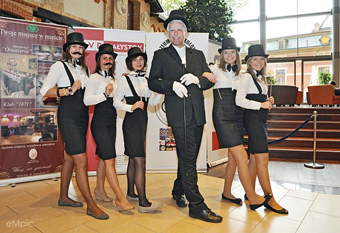 All
properties are from Start onwards: All
properties are from Start onwards:
Świetochłowice
- Kasa społeczna
(Community
Chest) - Bełchatów
-
Podatek Dochodowy (Income Tax)
- Dworzec kolejowy (= Railway station) -
Warszawa
- Szansa
- Lublin
- Katowice
- W Wiezieniu (In
Jail)
- Torun
- Telefonia
komórkwa (= Mobil telephone) - Rybnik
- Łódz
- Lotnisko
(= Airport) - Chojnice-
Kasa społeczna
(Community Chest) - Elbląg
- Szcecin
- Darmowy
parking (Free parking) - Zielona
Góra-
Szansa
- Bydgoszcz
- Tarnów
- Dworzec
metra (=
Metrostation) - Piotrków
Trybunalski
-
WrocŁaw
-
Portal Społ
ecznościowy (Social Network) - Kalisz
- Idź
do więzienia
(Go
to Jail)
- Kraków
- Gdynia
- Kasa społeczna
(Community Chest) - Poznań
- - Szansa
-
Gorzów
- Domiar
Podatkowy and BiaŁystock.
The presentation of this edition to the voters was in their favorite town BiaŁystock
with some show including a Polish Mr. Monopoly, see the picture. It is not clear
to me why the girls have a "black (!) mustache on a stick".
Should there be a certain relation to Mr. Monopoly's grey
mustache?
In my copy of this edition is such a mustache on a stick as well. Is it standard
belonging to the game?
This is a strange
edition. It ought to be a member of a series of very special country
editions, but it unfortunately became more or less an ordinary version. Perhaps
it is just because of that fact it became a special edition after all?
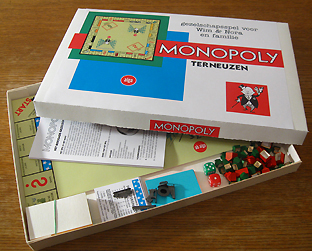 Edition:
Terneuzen - NL - handmade City edition - Sinterklaas present Edition:
Terneuzen - NL - handmade City edition - Sinterklaas present
Date of donation: December 5, 2011
Maker: Bartosz Czołczyński - Gdynia - PL, Designer of paper models
Dimensions of the box:43.0 x 28.5 x 3.0 cm
The game:
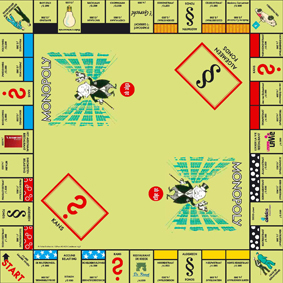 This handmade Dutch city edition is a very special one because of:
This handmade Dutch city edition is a very special one because of:
 | It is made by Bartosz, a Polish designer of paper models as a gift
to his
Dutch collegue designer in the
city of Terneuzen - NL. |
 | He decided the present to be for a very Dutch celebration: Sinterklaas,
on December 5th. Often such kind of self-made Monopoly games are for
special occasions like birthdays and
mariages, but this is the first one
made as a Sinterklaas gift! |
 | He used the design of a Swedish game from about 1976, see chapter
http://www.muurkrant.nl/monopoly/sweden.htm.
Bartosz explains why: "My father bought the edition we have as he was
in Sweden in 1974. In that time Monopoly
was unknown in Poland
and there was even a problem with dictonaries. My father (I was only 1 year
old!) had to translate
the Rules using Swedish-Russian and Russian-Polish
dictonaries.
I intended to make a copy
of this Swedish game, which is quite old and some parts are
used.
But during the work I got the
idea to change something and so I finally decided
to make a gift." |
 | Everything except the dice is made out of paper.
|
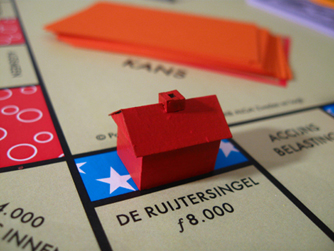 All
properties of this edition are from Start All
properties of this edition are from Start 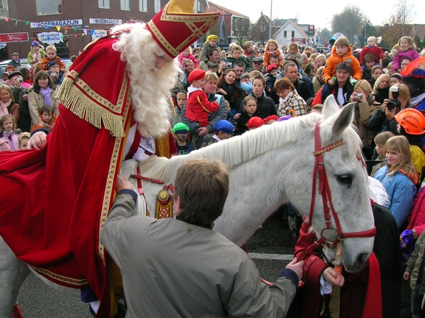 onwards: onwards:
Techniekstraat (with
bubbles) - -Productiestraat
(with
bubbles) -
Inkomstenbelasting (Income Tax) - Het
Arsenaal Restaurant
-
Beneluxweg
- Kans
(Chance) - Zwedenweg
- Polenweg -
Bezoeken in de
gevangenis - Ravelpad - Elektriciteitcentrale
- Bachlaan -
Chopinlaan
-
Stadscafé 't Gerecht
- Edisonstraat
(with
screen of red lines) - Celciusstraat
(with
screen of red lines)
--Madame Curiestraat
- Vrij
Parkeren - Van
Diemanstraat - Kans
- Jan
van Galenstraat -
Trompstraat
- Lekker la Vie Restaurant
- Julianastraat
(with
bubbles) - Bernhardstraat
(with bubbles) -
"Deco-plant" Vides industriewater
- Beatrixstraat (with
bubbles) - Naar
de Gevangenis - Korte
Kerkstraat -
Nieuwstraat
- § Algemeen
Fonds (Community Chest) - Noordstraat
- Restaurant "De Kreek"- Kans
-
Scheldeboulevard
(with stars) - Accijns
Belasting (Duty
tax) and De
Ruytersingel
(with stars).
All properties are grouped in related streetnames, eg. Ravelpad,
Bachlaan and Chopinlaan. Of course the streets are carefully chosen, taking into
account the values of the "real game", so I took the cheapest streets from industrial area of
Terneuzen, next ones from the harbour area etc.. The only exception is the last, most
expensive, street which is named 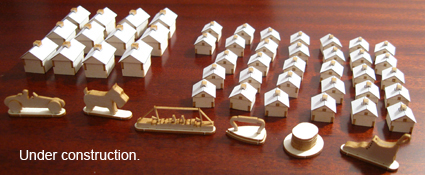 after
the street where my friend lives. By
the occasion of choosing street names, I have "smuggled" three names
connected to Poland: Polenweg, Chopinlaan and Madame Curiestraat. Because
there are no railway stations in Terneuzen I decided to use these spaces
for local restaurants. "Although the Alga logo in the red
dot on the lid refers to the manufacturer of the Swedish editions I decided to keep the logo as
it adds a nice visual detail on the board and box" Bartosz explains. after
the street where my friend lives. By
the occasion of choosing street names, I have "smuggled" three names
connected to Poland: Polenweg, Chopinlaan and Madame Curiestraat. Because
there are no railway stations in Terneuzen I decided to use these spaces
for local restaurants. "Although the Alga logo in the red
dot on the lid refers to the manufacturer of the Swedish editions I decided to keep the logo as
it adds a nice visual detail on the board and box" Bartosz explains.
The "well known" 6 tokens: car - dog - ship - iron - hat and
shoe are made of .... paper.
The banknotes are simply copied from those of the Swedish edition,
only the colors are different and the currency is in gulden, no euro! The
denominations are: 50 - 200 - 500
- 1000 - 2000
and 10000 (on white paper).
The paper houses are green and the hotels
are red. They both have a centric placed,
square chimney.
One wooden die is red, the other one
is green. They have white pips.
|